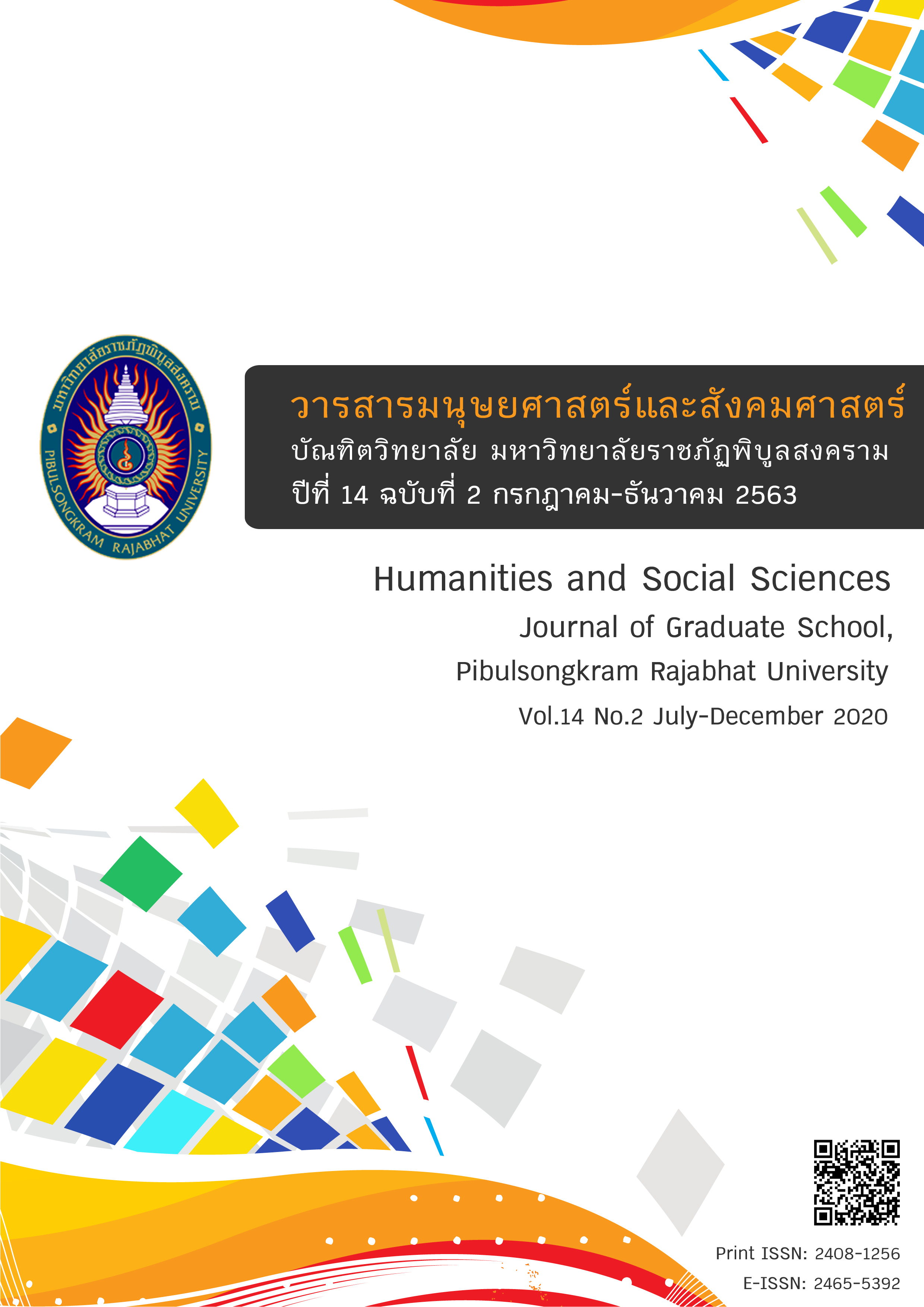การพัฒนารูปแบบการวิเคราะห์แก้ไขปัญหาในกระบวนการผลิต สำหรับหัวหน้างานของอุตสาหกรรมเสื้อผ้า
คำสำคัญ:
การบริหารทรัพยากรมนุษย์, ทักษะการวิเคราะห์แก้ไขปัญหา, กระบวนการผลิต, อุตสาหกรรมเสื้อผ้าบทคัดย่อ
การวิจัยครั้งนี้มี 3 วัตถุประสงค์หลัก คือ เพื่อศึกษาองค์ประกอบของการวิเคราะห์แก้ไขปัญหาในกระบวนการผลิตสำหรับหัวหน้างานของอุตสาหกรรมเสื้อผ้า เพื่อพัฒนารูปแบบการวิเคราะห์แก้ไขปัญหาในกระบวนการผลิตสำหรับหัวหน้างานของอุตสาหกรรมเสื้อผ้า และเพื่อประเมินการวิเคราะห์แก้ไขปัญหาในกระบวนการผลิตสำหรับหัวหน้างานของอุตสาหกรรมเสื้อผ้า โดยเป็นการวิจัยเป็นแบบผสมผสาน ประกอบด้วยการวิจัยเชิงปริมาณ และการวิจัยเชิงคุณภาพ กลุ่มตัวอย่างแบ่งออกเป็น 2 กลุ่ม คือ 1) กลุ่มตัวอย่างเชิงคุณภาพ ได้แก่ กลุ่มผู้ให้ข้อมูลสัมภาษณ์เชิงลึก ได้แก่ ผู้บริหารโรงงาน ผู้จัดการฝ่ายผลิต และผู้เชี่ยวชาญ จำนวน 12 คน สนทนากลุ่มผู้เชี่ยวชาญ จำนวน 13 คน กลุ่มผู้ตอบแบบสอบถาม หัวหน้างานในโรงงานอุตสาหกรรมการเสื้อผ้า จำนวนก 513 คน และ กลุ่มผู้ทดลองใช้คู่มือการพัฒนา จำนวน 30 คน 2) กลุ่มตัวอย่างเชิงปริมาณ ได้แก่ หัวหน้างานในโรงงานอุตสาหกรรมเสื้อผ้า จำนวน 364 คน เครื่องมือที่ใช้ในการวิจัยนี้ประกอบด้วย แบบสัมภาษณ์เชิงลึก และแบบสอบถาม ซึ่งนำข้อมูลที่ได้มาวิเคราะห์ด้วยสถิติได้แก่ การวิเคราะห์องค์ประกอบเชิงสำรวจ และสัมประสิทธิ์สหสัมพันธ์ร่วมกับการวิเคราะห์เชิงเนื้อหา ผลการวิจัยพบว่า องค์ประกอบของการคิดวิเคราะห์แก้ไขปัญหาสำหรับหัวหน้างานของอุตสาหกรรมการผลิตเสื้อผ้ามีทั้งหมด 8 ด้าน คือ 1) การระบุปัญหา 2) การเก็บรวบรวมข้อมูล และค้นหาสาเหตุ 3) การวิเคราะห์ปัญหา 4) การจัดหมวดหมู่และเชื่อมโยง 5) การสรุปความ 6) การวางแผนจัดการกับปัญหา 7) การประยุกต์นำไปใช้ 8) การตรวจสอบ ซึ่งองค์ประกอบทั้ง 8 ด้านนี้มีความเชื่อมโยงสัมพันธ์กันทุกองค์ประกอบ โดยผู้วิจัยได้นำผลการวิจัยพัฒนาต่อยอดด้วยการสร้างคู่มือการพัฒนาทักษะการคิดวิเคราะห์แก้ไขปัญหาสำหรับหัวหน้าฝ่ายผลิตในอุตสาหกรรมการผลิตเสื้อผ้า รวมทั้งจัดอบรมเพื่อส่งเสริมการฝึกทักษะด้านนั้น ผลลัพธ์ที่ได้จากการทดลอง คือ หัวหน้างานมีทักษะในการคิดวิเคราะห์การปฏิบัติงานเพิ่มขึ้น และสามารถพัฒนาต่อยอดการทำงานให้ดีขึ้น
เอกสารอ้างอิง
กัลยา ตากูล. (2550). การศึกษาการจัดกิจกรรมการเรียนรู้ และสภาพแวดล้อมเพื่อส่งเสริมทักษะการคิดและกระบวนการแก้ปัญหาอนาคตของนักเรียนชั้นมัธยมศึกษาปีที่ 3 : กรณีศึกษาโรงเรียนวชิราวุธวิทยาลัย (วิทยานิพนธ์ครุศาสตรมหาบัณฑิต). จุฬาลงกรณ์มหาวิทยาลัย, กรุงเทพฯ.
กิ่งแก้ว เอี่ยมแฉล้ม, คณิต เฉลยจรรยา และสุภัททา ปิณฑแพทย์. (2557). การพัฒนาสมรรถนะแรงงานใหม่ในอุตสาหกรรมสิ่งทอ. วารสารพัฒนาเทคนิคศึกษา มหาวิทยาลัยเทคโนโลยีพระจอมเกล้าพระนครเหนือ, 27(92), 62-69.
ทรงพล เพ็ชรทอง, สุวิมล ตั้งสัจพจน์, กุลยา ตันติผลาชีวะ และกรัณฑรัตน์ บุญช่วยธนาสิทธิ์. (2554). การพัฒนาหลักสูตรฝึกอบรมเสริมความรู้การเป็นผู้นำนันทนาการ สำหรับนิสิตปริญญาตรี. วารสารคณะพลศึกษา, 15(1), 88-96.
นภาพิไล ลัทธศักดิ์ศิริ. (2558). การพัฒนาหลักสูตรการฝึกอบรมเพื่อสร้างเสริมทักษะการแก้ปัญหาและการตัดสินใจสำหรับพนักงานระดับหัวหน้างานของศูนย์บริการลูกค้าธุรกิจยานยนต์ ในภาคตะวันออกประเทศไทย. วารสารการศึกษาและการพัฒนาสังคม, 11(2), 235-246.
พัชรี สร้อยสกุล. (2559). การพัฒนาทักษะแห่งศตวรรษที่ 21 สำหรับนักศึกษาอาชีวศึกษาเอกชนในเขตพัฒนาอุตสาหกรรมชายฝั่งทะเลตะวันออก (วิทยานิพนธ์การศึกษาดุษฎีบัณฑิต). มหาวิทยาลัยบูรพา, ชลบุรี.
ศูนย์วิจัยกสิกรไทย. (2561). ระเบียงเศรษฐกิจภาคตะวันออก (EEC) นโยบายสนับสนุนอุตสาหกรรมแห่งอนาคต. สืบค้น 18 สิงหาคม 2561, จาก https://www.thansettakij.com/content/107877.
สํานักงานคณะกรรมการพัฒนาการเศรษฐกิจและสังคมแห่งชาติ. (2561). ยุทธศาสตร์ขีดความสามารถในการพัฒนาการแข่งขัน. สืบค้น 18 สิงหาคม 2561, จาก https://thaitextile.org/th/insign/detail.251.1.0.html
สำนักงานส่งเสริมวิสาหกิจขนาดกลางและขนาดย่อม. (2560). แผนปฏิบัติการส่งเสริมวิสาหกิจขนาดกลางและขนาดย่อมรายสาขา อุตสาหกรรมสิ่งทอและเครื่องนุ่งห่ม. สืบค้น 26 กรกฎาคม 2560, จาก http://www.oic.go.th/
เสาวนีย์ สมันต์ตรีพร. (2560). การบริหารทรัพยากรมนุษย์ในภาคธุรกิจในยุคการเปลี่ยนแปลง. วารสารวิชาการมหาวิทยาลัยกรุงเทพธนบุรี, 6(1), 1-15.
อลงกรณ์ เลิศปัญญา. (2562). การพัฒนาหลักสูตรฝึกอบรมครูในการจัดการเรียนการสอนวิชาชีพเพื่อพัฒนาทักษะการคิดแก้ปัญหางาน. วารสารวิชาการครุศาสตร์อุตสาหกรรม พระจอมเกล้าพระนครเหนือ, 10(2), 138-147.
Certo, S. C. (2000). Modern management. New Jersey: Prentice-Hall.
Gagne, R. M., & Briggs, L. (1974). Principle of instruction design. New York: Holt, Rinechart and Winston.
Krulik, S., & Rudnick, J. A. (1998). Problem solving. Massachusetts: Allyn and Bacon.
Marzano, R. J. (2001). Designing a new taxonomy of educational objective. California: Corwin Press.
McNamara, J. F., & Chisolm, G. B. (1988). The technical tools of decision making. Handbook of Research on Educational Administration. A Project of the American Educational Research Association. New York: Harcourt Brace and Word.
Pegasus, C. (2013). The System thinking. Retrieved June 8, 2017, from https://thesystemsthinker.com/about/
Soden, R. (1994). Teacher Problem Solving in Vocation Education. Londen: Routledge.
Spiegler, M. D., & Guevremont, D. C. (1998). Contemporary Behavior Therapy (3rd ed.). New York: Brooks/Cole.
Sweeney, L. A. B., & Sherman, J. D. (2001). Bathtub dynamics: Initial results of a systems thinking inventory. System Dynamics Review, 16(4), 249-286.
Watson, G., & Glaser, E. M. (1964). Watson-Glaser Critical Thinking Appraisal Manual. New York: Harcourt, Brace & World.
Yamane, T. (1973). Statistics: An Introductory Analysis (3rd ed.). New York: Harper and Row Publication.
ดาวน์โหลด
เผยแพร่แล้ว
รูปแบบการอ้างอิง
ฉบับ
ประเภทบทความ
สัญญาอนุญาต
บทความหรือข้อคิดเห็นใดใดที่ปรากฏในวารสารมนุษยศาสตร์และสังคมศาสตร์ มหาวิทยาลัยราชภัฏพิบูลสงครามเป็นวรรณกรรมของผู้เขียน ซึ่งบรรณาธิการไม่จำเป็นต้องเห็นด้วย บทความที่ได้รับการตีพิมพ์เป็นลิขสิทธิ์ของวารสารมนุษยศาสตร์และสังคมศาสตร์ มหาวิทยาลัยราชภัฏพิบูลสงคราม









